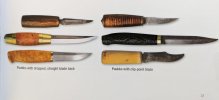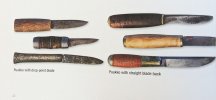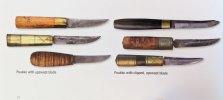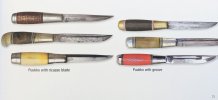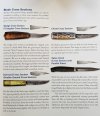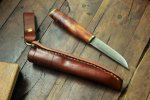-
The BladeForums.com 2024 Traditional Knife is available! Price is $250 ea (shipped within CONUS).
Order here: https://www.bladeforums.com/help/2024-traditional/
You are using an out of date browser. It may not display this or other websites correctly.
You should upgrade or use an alternative browser.
You should upgrade or use an alternative browser.
The Puukko
- Thread starter t.sous11
- Start date
The Zieg
Gold Member
- Joined
- Jan 31, 2002
- Messages
- 5,004
Good book!To the "point" of authentic puukko blade shapes - there are more than a few.
These photos from THE PUUKKO book by Ansi Ruusuvuori - a pretty reliable source.
View attachment 2134430
View attachment 2134431
View attachment 2134432
They can feature RICASSO too.
View attachment 2134433
Zieg
Yes, the puukko doesn't have one particular shape or size. Its just a word for a smallish utility knife. Seems to me that many definitions of the puukko use the Kauhavan style as an example as that is what we in the West have seen predominantly over the years and are most familiar with. I think that the word puukko is more like the English term pocket knife - a multi purpose knife with no real specific design parameters other than its small and easy to carry in your pocket. In addition, there are different types of puukkot - erapuukko, voulupuukko, metsastypuukko, partiopuukko etc depending on what is used for.
Love the solid infoTo the "point" of authentic puukko blade shapes - there are more than a few.
These photos from THE PUUKKO book by Ansi Ruusuvuori - a pretty reliable source.
View attachment 2134430
View attachment 2134431
View attachment 2134432
They can feature RICASSO too.
View attachment 2134433
SwissHeritageCo
Knifemaker / Craftsman / Service Provider
- Joined
- Jan 8, 2021
- Messages
- 3,571
People get way too hung up on "what is a puukko" and it's origins etc, imho. Just like they do on scandi grinds.
RayseM
Platinum Member
- Joined
- Feb 18, 2010
- Messages
- 8,269
kamagong
Gold Member
- Joined
- Jan 13, 2001
- Messages
- 10,962
People get way too hung up on "what is a puukko" and it's origins etc, imho. Just like they do on scandi grinds.
Agreed, but it is often necessary. Words have meaning, and using words carelessly robs them of those meanings. That's how we end up with the odious use of the term wharncliffe to describe the blade on the Benchmade Immunity.
Hammer67
Gold Member
- Joined
- Nov 9, 2012
- Messages
- 10,678
People get way too hung up on "what is a puukko" and it's origins etc, imho. Just like they do on scandi grinds.
Agreed. We modern knife nerds have a tendency to get way too narrowly specific and tend to want to strictly define and pigeonhole things. In my experience, in most of the world where knives are just practical tools, this is not at all the case, and there is often a fair bit of fluidity in terminology when it comes to "this" type of knife vs. "that" type of knife. Sometimes it may vary even from one region to the next.
For sure. When terms are used flat-out improperly, that's a different thing. Like you said, "wharncliffe" is a good example - I cringe when I see how this term gets applied to some modern knives, and also how many people apparently don't understand what an actual wharncliffe is. But I think there's a reasonable middle ground between being overly rigid in terms of definitions and being too sloppy with terminological applications.Agreed, but it is often necessary. Words have meaning, and using words carelessly robs them of those meanings.
As an aside, I believe one of the practical features of the upswept Nordic/puukko blade design was for using the knife to fetch a kettle from the fire, by picking up the bail with the spine of the knife. The upswept tip kept the kettle from sliding off.
- Joined
- Jul 3, 2019
- Messages
- 14,799
Agreed, and in this case we have the time and luxury to hash it out.Agreed, but it is often necessary. Words have meaning, and using words carelessly robs them of those meanings. That's how we end up with the odious use of the term wharncliffe to describe the blade on the Benchmade Immunity.
As a direct result of this, I think I have a new book I'm interested in buying, so it's really a win all around.
Except in this case its what gets lost in translation that contributes to misunderstanding what the word really means....Agreed, but it is often necessary. Words have meaning, and using words carelessly robs them of those meanings. That's how we end up with the odious use of the term wharncliffe to describe the blade on the Benchmade Immunity.
SwissHeritageCo
Knifemaker / Craftsman / Service Provider
- Joined
- Jan 8, 2021
- Messages
- 3,571
That's a fair point.Agreed, but it is often necessary. Words have meaning, and using words carelessly robs them of those meanings. That's how we end up with the odious use of the term wharncliffe to describe the blade on the Benchmade Immunity.
Will Power
Gold Member
- Joined
- Jan 18, 2007
- Messages
- 33,567
Well, the word is used quite loosely here...can more or less refer to any fixed blade knife...partly because the concept of a knife IS a puukko to people here, what else could there be???  Its popularity and efficacy spread abroad to Sweden/Norway, Russia. Lapland and the Samí people range over north Finland, Sweden, Norway and Russia. When Finland was an autonomous Duchy of Russia 1809-1917, puukko were made as presentation gifts to the Tsars and the Russian word for puukko is literally Finnish Knife (can't do Cyrillic here) same too in Polish.
Its popularity and efficacy spread abroad to Sweden/Norway, Russia. Lapland and the Samí people range over north Finland, Sweden, Norway and Russia. When Finland was an autonomous Duchy of Russia 1809-1917, puukko were made as presentation gifts to the Tsars and the Russian word for puukko is literally Finnish Knife (can't do Cyrillic here) same too in Polish.
Here's the dictionary
 www.kielitoimistonsanakirja.fi
www.kielitoimistonsanakirja.fi
Got that? Well paraphrase, single blade, knife as a working-tool whose tang is often the same size as the blade. My thanks to The Institute of National Language.
Well paraphrase, single blade, knife as a working-tool whose tang is often the same size as the blade. My thanks to The Institute of National Language.
People here can and do bicker about 'pure' puukko. methods of forging etc regional differences, sheathes. But basically it is a relatively compact, lightweight knife, sunken tang with handle of wood, stacked leather, bark or contemporary materials with a genius sheath that makes the knife much more difficult to lose and much more comfortable to wear. Blade shape a secondary question really. As I said, primarily a working-tool for woodwork, carving, whittling, fire-making, gutting and butchering according to need. It functions well.
Here's the dictionary
Kielitoimiston sanakirja
Kielitoimiston sanakirja on Kotimaisten kielten keskuksessa laadittu suomen yleiskielen sanakirja.
Got that?
People here can and do bicker about 'pure' puukko. methods of forging etc regional differences, sheathes. But basically it is a relatively compact, lightweight knife, sunken tang with handle of wood, stacked leather, bark or contemporary materials with a genius sheath that makes the knife much more difficult to lose and much more comfortable to wear. Blade shape a secondary question really. As I said, primarily a working-tool for woodwork, carving, whittling, fire-making, gutting and butchering according to need. It functions well.
wickettedge
Platinum Member
- Joined
- Mar 31, 2018
- Messages
- 2,663
SwissHeritageCo
Knifemaker / Craftsman / Service Provider
- Joined
- Jan 8, 2021
- Messages
- 3,571
kamagong
Gold Member
- Joined
- Jan 13, 2001
- Messages
- 10,962
That looks great!!!
 The color of the sheath goes very well with the knife's handle.
The color of the sheath goes very well with the knife's handle.SwissHeritageCo
Knifemaker / Craftsman / Service Provider
- Joined
- Jan 8, 2021
- Messages
- 3,571
That looks great!!!The color of the sheath goes very well with the knife's handle.
It's officially in route back to you.
Was refreshing to see that nice naturally earned patina on your blade
kamagong
Gold Member
- Joined
- Jan 13, 2001
- Messages
- 10,962
It's officially in route back to you.
Was refreshing to see that nice naturally earned patina on your blade
"You actually used it!?"
That puukko is one of my favorite knives.
SwissHeritageCo
Knifemaker / Craftsman / Service Provider
- Joined
- Jan 8, 2021
- Messages
- 3,571
"You actually used it!?"
...lol.
That puukko is one of my favorite knives.
Exactly.
That arctic willow has held up really well too, strange how people think natural wood handles are delicate and I'm surprised more makers don't pay attention to simple things like balance. It's a big deal.
+1 for those production puukko brands like ahti, kauhavan, erapuu and martiini.
The maker is puukkoseppamestari Mikko Inkeroinen. Per his notes, the wood is arctic willow.
You sure that is arctic willow? Looks more like Goat willow. Arctic willow (Salix arctica) doesn't grow large enough to make a handle from....Goat willow, other wise known as sallow root, is pretty tough stuff.....
Last edited:
kamagong
Gold Member
- Joined
- Jan 13, 2001
- Messages
- 10,962

